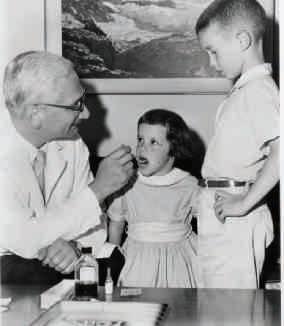Bring a Spoon A C I N C I N N AT I S T O RY O F S A B I N S U N DAYS A N D T H E P O L I O VACC I N E YO U N G E Y E S O N T H E PA S T BY CORINNE ADAMS
I chose to research the introduction of Dr. Albert Sabin’s oral polio vaccine in Cincinnati for my National History Day project. I was interested by this local story and had heard that tens of thousands of children were vaccinated in a single week; I could not fathom how that could be done! In my initial research, I discovered extensive coverage of the oral polio vaccine program in newspapers, which became one of my mostused sources. I relied heavily on The Enquirer and The Cincinnati Post. Advertisements, informational articles, pictures and even thank-you letters appeared in these newspapers. GREAT PRIMARY SOURCES In addition to newspaper articles, I employed a large range of essays, books and other articles relating to the vaccine and Dr. Sabin.
I found especially great value in interviews with many older citizens of Cincinnati who remembered personal experiences about polio in the 1950s and ‘60s or even remembered receiving the vaccine. These Cincinnatians were great primary sources because they shared real tales. I also had the privilege of going to the Albert Sabin Archives at the University of Cincinnati, which provided dozens of essential documents including letters, manuscripts, laboratory notebooks, telegrams, advertisements and more. For my exhibit, I displayed a multitude of pictures and newspaper articles. I incorporated threedimensional components like 3-D printed polio viruses, a map with labeled vaccination clinics and printed letters, pamphlets and interview quotes. I added multiple spoons to the display to remind the viewer of the vaccine advertising campaign slogan, Bring a Spoon. My board was divided into four main sections. The first was the background context, including information on Albert Sabin, his creation of a vaccine, his rivalry with Jonas Salk and the polio virus. SABIN SUNDAYS
Cincinnati's Dr. Albert Sabin administers his polio vaccine. 48 Echoes | JANUARY & FEBRUARY 2021
The second was Sabin Sundays, detailing the activities and process of vaccinating all the children of Cincinnati. The third was Cincinnati Working Together, explaining the use of free advertising and the ways the citizens of Cincinnati collaborated to achieve their vaccination goal. The final section, Impacts, consisted of information about the decrease
in polio, the rise of public service announcements and the gratitude of Cincinnatians. Albert Sabin and the citizens of Cincinnati broke barriers in medicine and technology and the barrier of public awareness in Cincinnati to provide protection from polio throughout the city. These barriers were broken by means of a new oral vaccine, an information campaign with free advertising and news coverage and community commitment. The rivalry between Sabin and Salk fueled the race for a vaccine and colored the debate around vaccine safety and herd immunity. Before the introduction of the Sabin vaccine, the citizens of Cincinnati lived in fear of polio, but they felt free to live their lives after their children were vaccinated. Now, 60 years since the first Sabin Sundays, polio is little more than a historical curiosity in most of the world, a perfect example of the 2020 National History Day theme, Breaking Barriers. When I chose this topic, I, like the rest of the world, had no knowledge of the impending pandemic that would upend day-to-day life in the coming months (including eventually preventing me from competing in person at the Ohio and National History Day events) and resulting in many deaths and economic repercussions. CURRENT EVENTS THROUGH A NEW LENS Now, as the world scrambles to produce an effective vaccine for COVID-19, I have a new lens to look at current events. In the 1950s, people were scared for their children and didn’t know the best ways to protect them, leading to the massive cry for a vaccine.








